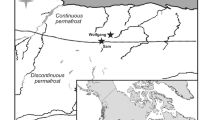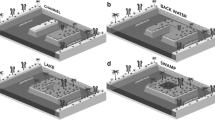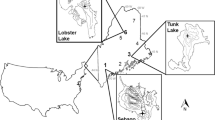Abstract
Water-level fluctuations (WLF) often represent one of the greatest impacts on the development of lake ecosystems. In the year 1931, the Trentino Hydroelectric Company (SIT) requested the hydroelectric use of water bodies in the Upper and Middle Sarca basin. The largest and deepest lakes were dammed to increase lake volume and exploited since mid 1950s. This research uses the sediment record of two small lakes in close proximity to each other (Garzonè and Serodoli) in northern Italy, used for hydroelectric power generation to determine the dependence of diatom-assemblage dynamics on WLF that have taken place over the last 60 years. Historical WLF are clearly reflected in the lithological composition and grain-size variations of the sediment cores. During the regression and transgression phases, the boundaries between the erosion, transport and accumulation zones fluctuated, causing redistribution of previously accumulated sediments, and their return into the lake’s cycling of biogeochemical matter. The water-level changes not only caused distinct taxonomic shifts in the diatom communities, which were dominated by different species in the core sections of each lake, but also significant shifts in the composition of the diatoms’ ecological, morphofunctional and life-form groups. Diatoms with a low- and high-profile attachment type were the dominant morphological forms in the upper core levels, where the most extreme fluctuations in water level had occurred. Increased turbulent mixing caused by WLF favours the presence of large, heavily silicified centric diatoms, while more stable levels would select for smaller centric diatoms through thermal stratification.







Similar content being viewed by others
References
Appleby PG (2000) Radiometric dating of sediment records in European mountain lakes. J Limnol 59(Suppl. 1):1–14
Appleby PG (2001) Chronostratigraphic techniques in recent sediments. In: Last WM, Smol JP (eds) Tracking environmental change using lake sediments, Vol. 1, basin analysis, coring, and chronological techniques. Kluwer, Dordrecht, pp 171–203
Bahls LL (1993) Periphyton bioassessment methods for Montana streams. Department of Health and Environmental Sciences. Water Quality Bureau, Helena, Montana
Baldi E (1932) Note zoologiche sopra alcuni laghi della Presanella, II: Il Lago Serodoli. Mem del Mus di St Nat Trento I:167–192
Baldwin DS, Gigneya H, Wilsonb JS, Watsona G, Boulding AN (2008) Drivers of water quality in a large water storage reservoir during a period of extreme drawdown. Water Res 42:4711–4724
Battarbee RW, Jones VJ, Flower RJ, Cameron NG, Bennion H, Carvalho L, Juggins S (2001) Diatoms. In: Smol JP, Birks HJB, Last WM (eds) Tracking environmental change using lake sediments.Volume 3: terrestrial, algal, and siliceous indicators. Kluwer Academic Publishers, Dordrecht, pp 155–202
Betti L (2003) Lo sfruttamento idroelettrico dei laghi d’alta quota del bacino del Sarca. Adamello Brenta Parco 7:6–11
Biggs BJF, Thomsen HA (1995) Disturbance of stream periphyton by perturbations in shear stress: time to structural failure and differences in community resistance. J Phycol 31:233–241
Bourassa N, Cattaneo A (1998) Control of periphyton biomass in Laurentian streams (Québec). J N Am Benthol Soc 17:420–429
Boyle JF (2001) Inorganic geochemical methods in palaeolimnology. In: Last WM, Smol JP (eds) Tracking environmental changes using lake sediments.Volume 3: physical and geochemical methods. Developments in Paleoenvironmental Research, Kluwer Academic Publishers, Dordrecht, pp 83–141
Cantonati M, Tolotti M, Lazzara M (2002) I laghi del Parco Naturale Adamello-Brenta. Ricerche limnologiche sui laghi di alta quota del settore siliceo del Parco. Documenti del Parco Naturale Adamello-Brenta and Museo Tridentino Scienze Naturali, Strembo
Cantonati M, Silvia S, Angeli N, Guella G, Frassanito R (2009) Environmental controls of epilithic diatom depth-distribution in an oligotrophic lake characterised by marked water-level fluctuations. Eur J Phycol 44:15–29
Clegg MR, Maberly SC, Jones RI (2007) Behavioral response as a predictor of seasonal depth distribution and vertical niche separation in freshwater phytoplanktonic flagellates. Limnol Oceanogr 52:441–455
Coops H, Beklioglu M, Crisman TL (2003) The role of water-level fluctuations in shallow lake ecosystems: workshop conclusions. Hydrobiologia 506(509):23–27
Corradini F, Boscaini A, Flaim G, Filippi ML, Borsato A, Zandonati M (2005) Fisica, idrochimica e idrologia del Lago di Lavarone (Trentino, Italia). Studi Trent Sci Nat Acta Geol 82:175–187
Digerfeldt G (1986) Studies on past lake-level fluctuations. In: Berglund BE (ed) Handbook of holocene palaeoecology and palaeohydrology. Wiley, New York, pp 127–144
Giussani G, de Bernardi R, Mosello R, Origgi I, Ruffoni T (1986) Indagine limnologica sui laghi alpini d’alta quota. Documenta Ist ital Idrobiol 9:415
Griffiths HI, Reed JM, Leng MJ, Ryan S, Petkovski S (2002) The conservation status and recent palaeoecology of Balkan Lake Dojran. Biol Conserv 104(1):35–49
Håkanson L (1977) The influence of wind, fetch, and water depth on the distribution of sediments in Lake Vanern, Sweden. Can J Earth Sci 14:397–412
Hawes I, Smith R (1994) Seasonal dynamics of epilithic periphyton in oligotrophic Lake Taupo, New Zealand. N Z J Mar Freshw 28:1–12
Heiri O, Lotter AF, Lemcke G (2001) Loss on ignition as a method for estimating organic and carbonate content in sediments: reproducibility and comparability of results. J Paleolimnol 25:101–110
Hodgson D, Vyvewrman W, Tyler P (1997) Diatoms of meromictic lakes adjacent to the Gordon River, and of the Gordon River estuary in south-west Tasmania. In: Bibliotheca diatomologica, Band 35. Berlin, J. Cramer
Hofmann G, Werum M, Lange-Bertalot H (2011) Diatomeen im Süßwasser-Benthos von Mitteleuropa. Bestimmungsflora Kieselalgen für die ökologische Praxis. Über 700 der häufigsten Arten und ihre Ökologie. ARG Gantner Verlag, Rugell, p 908
Houk V (2003) Atlas of freshwater centric diatoms with a brief key and descriptions. Part. I. Melosiraceae, Orthoseiraceae, Paraliaceae and Aulacoseiraceae. Czech Phycol Suppl 1:1–27
Imberger J (1994) Transport processes in lakes: a review. In: Margalef R (ed) Limnology now: a paradigm of planetary problems. Elsevier, New York, pp 99–193
James MR, Weatherhead M, Stanger C, Graynoth E (1998) Macroinvertebrate distribution in the littoral zone of Lake Coleridge, South Island, New Zealand: effects of habitat suitability, wind exposure, and macrophytes. N Z J Mar Freshw 32:287–305
Jonsson G (1992) Production and nutrient supply of phytoplankton in subarctic, dimictic Thingvallavatn, Iceland. Oikos 64:162–187
Juggins S (2003) Software for ecological and palaeoecological data analysis and visualization. C2 user guide. University of Newcastle, Newcastle-Upon-Tyne
Kilhan S, Theriot EC, Fritz SC (1996) Linking planktonic diatoms and climate change in the large lakes of the Yellowstone ecosystem using resource theory. Limnol Oceanogr 41:1052–1062
Krammer K, Lange-Bertalot H (1988–1991) Bacillariophyceae. In: Ettl H, Gerloff J, Heynig H, Mollenhauer D (eds) Süβwasserflora von Mitteleuropa, Band 2 (2–4). Gustav Fischer Verlag, Stuttgart
Krejci ME, Lowe RL (1987) The seasonal occurrence of macroscopic colonies of Meridion circulare (Bacillariophyceae) in a spring-fed brook. Trans Am Microsc Soc 106:173–178
Laird KR, Cumming BF (2008) Reconstruction of Holocene lake level from diatoms, chrysophytes and organic matter in a drainage lake from the Experimental Lakes Area (northwestern Ontario, Canada). Quat Res 69:292–305
Leira M, Cantonati M (2008) Effects of water-level fluctuations on lakes: an annotated bibliography. Hydrobiologia 613:171–184
MacIntyre S, Flynn KM, Jellison R, Romero JR (1999) Boundary mixing and nutrient fluxes in Mono Lake, California. Limnol Oceanogr 44:512–529
Madsen JD, Chambers PA, James WF, Koch WE, Westlake DF (2001) The interaction between water movement, sediment dynamics and submersed macrophytes. Hydrobiologia 444:71–84
Moos MT, Laird KR, Cumming BF (2005) Diatom assemblages and water depth in Lake 239 (ELA, Ont.): implications for paleoclimatic studies. J Paleolimnol 34:217–227
Munsell Soil Color Charts (1954) Munsell Color Co. Inc., Baltimore
Naselli-Flores L (2003) Man-made lakes in Mediterranean semi-arid climate: the strange case of Dr Deep Lake and Mr Shallow Lake. Hydrobiologia 506:13–21
O’Sullivan PE, Reynolds CS (eds) (2005) The lakes handbook, vol 2. Lake Restoration and Rehabilitation, Blackwell, Malden
Passy SI (2007) Diatom ecological guilds display distinct and predictable behavior along nutrient and disturbance gradients in running waters. Aquat Bot 86:171–178
Peterson CG, Stevenson RJ (1992) Resistance and resilience of lotic algal communities: importance of disturbance timing and current. Ecology 73(4):1445–1461
Poff NL, Voelz NJ, Ward JV, Lee RE (1990) Algal colonization under four experimentally-controlled current regimes in a high mountain stream. J N Am Benthol Soc 9:303–318
Punning J-M, Puusepp L, Koff T (2004a) Spatial variability of diatoms, subfossil macrophytes, and OC/N values in surface sediments of Lake Väike Juusa (southern Estonia). Proc Estonian Acad Sci Biol Ecol 53:147–160
Punning J-M, Alliksaar T, Terasmaa J, Jevrejeva S (2004b) Recent patterns of sediment accumulation in a small closed eutrophic lake revealed by the sediment records. Hydrobiologia 529:71–81
Reynolds CS (1988) The concept of biological succession applied to seasonal periodicity of phytoplankton. Verh Int Ver Limnol 23:683–691
Reynolds CS (2006) Ecology of phytoplankton. Cambridge University Press, Cambridge
Robbins JA, Edgington DN, Kemp ALW (1978) Comparative 210Pb, 137Cs, and pollen geochronologies of sediments from Lakes Ontario and Erie. Quatern Res 10:256–278
Rørslett B (1991) Principal determinants of aquatic macrophyte richness in northern European lakes. Aquat Bot 39:173–193
Round FE, Bukhtiyarova L (1996) Four new genera based on Achnanthes (Achnanthidium) together with a re-definition of Achnanthidium. Diatom Res 11:345–361
Round FE, Crawford RM, Mann DG (1990) The Diatoms. Biology and morphology of the Genera. Cambridge University Press, Cambridge
Schnurrenberger D, Russell J, Kelts K (2003) Classification of lacustrine sediments based on sedimentary components. J Paleolimnol 29:141–154
Schwarz A-M, Hawes I, Howard-Williams C (1996) The role of photosynthesis/light relationships in determining lower depth limits of Characeae in South Island, New Zealand lakes. Freshw Biol 35:69–80
Schwarz A, Howard-Williams C, Clayton J (2000) Analysis of relationships between maximum depth limits of aquatic plants and underwater light in 63 New Zealand lakes. N Z J Mar Freshw Res 34:157–174
Shteinman BS, Parparov AS (1997) An approach to particulate matter transfer studies in littoral zones of lakes with changing morphometry. Water Sci Technol 36:199–205
Shuman B, Henderson AK, Colman SM, Stone JR, Fritz SC, Stevens LR, Power MJ, Whitlock C (2009) Holocene lake-level trends in the Rocky Mountains, USA. Quat Sci Rev 28:1861–1879
Søballe DM, Kimmel BL (1987) A large-scale comparison of factors influencing phytoplankton abundance in rivers, lakes, and impoundments. Ecology 68:1943–1954
Steinman AD, McIntire CD, Lowry RD (1987) Effects of herbivore type and density on chemical composition of algal assemblages in laboratory streams. J N Am Benthol Soc 6:189–197
Steinman AD, McIntire CD, Gregory SV, Lamberti GA (1989) Effects of irradiance and grazing on lotic algal assemblages. J Phycol 25:478–485
Tardio M, Filippi ML, Corradini F (2005) Studio stagionale dei parametri chimico-fisici e del fitoplancton del Lago Nero di Cornisello. Studi Trent Sci Nat Acta Geol 82:165–173
Tarras-Wahlberg H, Everard M, Harper DM (2002) Geochemical and physical characteristics of river and lake sediments at Naivasha, Kenya. Hydrobiologia 488:27–41
ter Braak CJF, Ŝmilauer P (2002) CANOCO reference manual and CanoDraw for Windows user’s guide: software for canonical community ordination (version 4.5). Microcomputer Power, Ithaca, New York
Tomasi G (1962) Origine, distribuzione, catasto e bibliografia dei laghi del Trentino. St Trent Sci Nat 1–2:1–355
Tonolli V, Tonolli L (1951) Osservazioni sulla biologia ed ecologia di 170 popolamenti zooplanctonici di laghi alpini d’alta quota. Mem Ist Ital Idrobiol 6:53–136
Vilhena LC, Hillmer I, Imberger J (2010) The role of climate change in the occurrence of algal blooms: Lake Burragorang, Australia. Limnol Oceanogr 55:1188–1200
Wolin JA, Stone JR (2010) Diatoms as indicators of water-level change in freshwater lakes. In: Stoermer EF, Smol JP (eds) The diatoms: applications for the environmental and earth sciences, 2nd edn. Cambridge University Press, Cambridge, pp 174–185
Yangm H, Flower RJ, Battarbee RW (2009) Influence of environmental and spatial variables on the distribution of surface sediment diatoms in an upland loch, Scotland. Acta Bot Croat 68:367–380
Zucchelli M (1952) Osservazioni morfologiche e fisiche su alcuni laghi del Gruppo Adamello-Presanella. St Trent Sci Nat 29:142–170
Acknowledgments
We appreciate the constructive and helpful comments from two anonymous reviewers that improved the manuscript. We would like to express our thanks to Michele Zandonati, Massimiliano Tardio and Nicola Angeli for their help during fieldwork. Thanks are extended to Ermanno Bertuzzi, Daniel Spitale and Alessia Scalfi, all at The Museum of Natural Science, Trento. This study was financed by the Autonomous Province of Trento, Italy, within the multidisciplinary project “Lake Ritorto” (Water abstractions from a high mountain lake for artificial snow production) and a grant of the Human Resources program of the Galician Research, Development and Technological Innovation Plan (Xunta de Galicia) provided to Manel Leira.
Author information
Authors and Affiliations
Corresponding author
Rights and permissions
About this article
Cite this article
Leira, M., Filippi, M.L. & Cantonati, M. Diatom community response to extreme water-level fluctuations in two Alpine lakes: a core case study. J Paleolimnol 53, 289–307 (2015). https://doi.org/10.1007/s10933-015-9825-7
Received:
Accepted:
Published:
Issue Date:
DOI: https://doi.org/10.1007/s10933-015-9825-7




